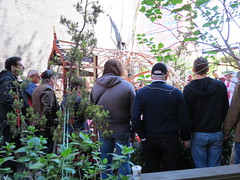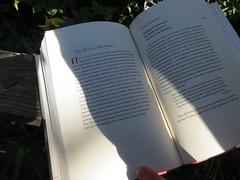A group of over 30 people gathered Saturday afternoon at Le Petit Versailles community garden to celebrate what would have been the 100th birthday of gay activist Harry Hay.
Mr. Hay, who died of lung cancer in 2002, was one of the first advocates of the concept of gay rights in the 1950s. He co-founded the Mattachine Society only to be expelled due to his Communist beliefs; later, he and others created the Radical Faeries, a spiritual society of gay men with sanctuaries around the world.
Peter Sturman, who joined the group shortly after coming out in his early twenties, said the faeries almost spoiled him to the realities of the outside world. “We go into a separate space and we get to suspend the rules of society,” he said.
So-called faerie sanctuaries tend to be in the middle of rural areas, forests, farmlands or deserts. Gatherings are sporadic, and can last from a day to several weeks. Last year, this garden tucked between Houston and East Second Streets, near Avenue C, became New York City’s sanctuary. It was a natural choice: according to radical faerie Johnathan Morpurgo, Le Petit Versailles has been gay-friendly ever since it was adopted by a group of homosexual anarchist filmmakers and artists in the 1980s.
Mr. Sturman, 43, said gay men who gather at the events can feel free to partake in whatever makes them feel like themselves, including cross-dressing, nudity, femininity and an open sexuality.
“It’s a spiritual thing,” he said. “We go there to heal from whatever we need to heal from.”
Robert Croonquist, who joined the faeries in 1972, first saw Mr. Hay in “Word is Out,” a 1977 documentary about the lives of gay men and women.
“My first impression was that he was really old, and it really was wonderful that there were cool, old gay people,” he said. He met Mr. Hay in 1981, during the second gathering of the Radical Faeries in Colorado, and later helped facilitate “sex magick workshops” in Oregon.
Mr. Croonquist said the workshops served as “safe containers for gay men to explore the real nature of who we are, and what it is our true gift as a separate people whose time has come.” They were conducted in circles where men shared inner truths and undertook consensual “sexual rituals of healing.”
Though they became friends over time, Mr. Croonquist said their pseudo-student-teacher relationship led to confrontations with Mr. Hay, who had high expectations of those around him.
“We’d really blow up at each other,” he said. “Harry was ferocious. He was a little cowering sissy inside, but he was a ferocious lion outside.”
In the early afternoon, some members of the Occupy Wall Street movement wandered into the garden. The group gathered in a circle around an igloo-shaped wooden structure and took turns reading lines from “A Call to Gay Brothers,” a manifesto quoted in ”Radically Gay,” a collection of Mr. Hay’s speeches.
Bill Dobbs, a gay activist who was also at the event, said Mr. Hay’s radical vision went beyond achieving equality.
“He was something of a chauvinist,” said Dobbs. “He thought gay people were special, perhaps out of the challenge of being different.”
One of Mr. Hay’s accomplishments was to combine two words that until then weren’t seen together: radical, a loaded adjective that scared many in the era of McCarthyism, and fairy, a derogatory term used against homosexuals.
“Each one of them said separately conjured different images and ideas, but put them together…” said a man who identified himself as Ask Nicely, his faerie name. “That’s special.”
For Ask Nicely, Mr. Hay was much more than an advocate of gay rights. “He was sitting on different committees, on different things, but also being out queer,” he said. “In doing anti-nuclear, anti-war, anti-gentrification stuff, he was a political animal involved as an out gay man.”
As night drew nearer, Mr. Sturman led a rendition of Woody Guthrie’s “This Land Is Your Land” while other members of the society conversed and shared a potluck. After singing the traditional “Happy Birthday” song for Mr. Hay, those gathered under the park’s wooden roof passed around pieces of cake.
On May 1, the faeries will return to the garden on for their annual “May Pole” ceremony, in which they dance around a recently-cut tree branch in the middle of the garden and cover it in ribbons. Afterwards, the pole is removed to a corner of the park, where it remains until the next year’s ceremony, and the space is cleared for artistic performances to be held year round.
“This park is a real community space centered around art,” said Frank Susa, who has been a radical faerie for over ten years. “It’s not just gay, but it includes us.”






